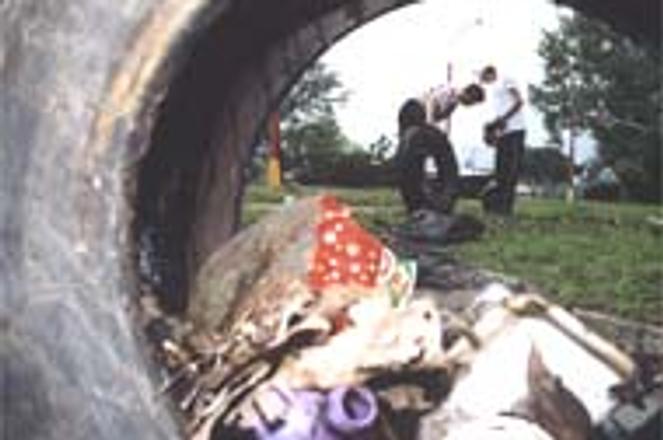Workers remove garbage from a parking lot west of the New Bridge on the Danube River as part of a summer clean-up campaign for the capital.photo: Ján Svrček
Armed with trash bags and the goal of turning Bratislava into a 'zelené mesto' (green city), a group of 100 mainly university-age students has taken to the streets of the capital in a mass clean-up effort.
The six-week programme is running for the third consecutive year, and is being organised by the Old Town mayor's office and funded by tobacco firm Philip Morris Slovakia.
"There's a lot of work to do," said Old Town Mayor Andrej Ďurkovský. "We're trying to show and teach people that if we want to live in a nice environment, it depends purely on us."
The project was necessary, he continued, because Slovaks around the country have become apathetic about trash in public. "It's not unusual, for example, for people to dispose of their old kitchen appliances in parks. People have no qualms about starting an illegal dump site almost anywhere," Ďurkovský said.
The Green City project lasts from July 16 to August 24 and includes a clean-up of Bratislava's Horský park area. The most frequented green area in the city centre, Horský park will have 60 bird feeders erected in order to attract new bird varieties and sustain the almost 40 bird species which already live in the park. Horský park's damaged benches will also be repaired.
Around Old Town, hundreds of trees and bushes will be planted to create more green space in the city (hence the project's name). Moreover, the Vajanského and Ludvík Svoboda nábrežie banks of the Danube River will be scoured. Illegal dumps, such as those on Slávičie údolie, Kalvária, and Sokolská and Šancová Streets, will be eradicated. The inner courtyards of housing estates on Palárikova, Palisády, Zámocká, Blumentálska, and Špitálska Streets will also be put into cleaner trim.
After poor results employing senior citizens and the jobless, the city has this year had more success with natural sciences students.photo: Ján Svrček
The authors of the annual project say that the clean-up is needed in Bratislava not only to create a better atmosphere in places foreign visitors are likely to visit, but also to convince Bratislava residents that living in a rubbish-free, environmentally-friendly area is something to be desired.
"For some reason, people in this city have lost touch with the environment over the past few years," said Kamil Procházka, head of the Save Horský Park foundation (NZHP). "Horský park is all too often full of trash. People here just throw out plastic bottles and such without realising that it shouldn't be done."
"I'm thankful that the Old Town is organising this project," he continued. "For me, this means that people's attitudes toward the maintenance of our environment is starting to change for the better."
Mayor Ďurkovský said that the Old Town district was forced this year to allocate 22% of its total annual spending (85 million Slovak crowns, or $1.7 million) on city maintenance and clean-up. Projects like this one, he said, relieved the burden on the city.
Most project workers are university students, earning a modest salary of 45 Slovak crowns (90 cents) per hour. Last year, the unemployed and retired members of the Bratislava community were also recruited for the work, but organisers said that that strategy had largely failed.
"The interest of people in helping last year was minimal," Ďurkovský said. "But young people seem to be more sensitive about environmental issues than the older generations. Our experience is that those who show interest in working on the Green City project are usually natural sciences students."
Participating students said they had decided to help for various reasons, such as spending the summer with their peers, earning a little money, and helping the environment.
Green City workers carried out of the city some 52 tonnes of waste from illegal dumping areas last year alone. The workers also planted 1,713 trees and bushes and cleaned 42 kilometres of public streets. This year, says Barbora Popracová of the Old Town's Environmental Department, the workers will be asked to plant "as much vegetation as they can."
Green City organisers say they hope their project will be emulated by other districts, towns and cities around Slovakia. However, they admit, the project so far seems to have caught on only in the Bratislava Old Town.
"We were thinking about doing a similar project," said Petržalka Mayor Vladimír Bajan (Petržalka is one of 17 Bratislava districts). "Unfortunately, we haven't been so fortunate in finding a financial partner like the Old Town has."
Philip Morris Slovakia and Ďurkovský both refused to say how much the international tobacco firm had doled out for the programme.


